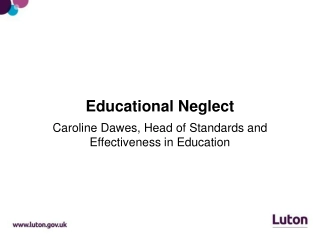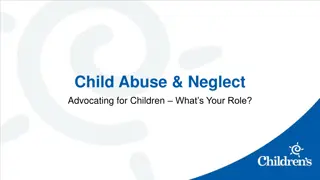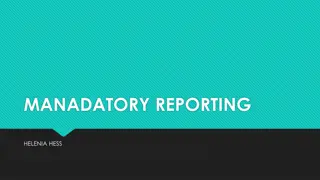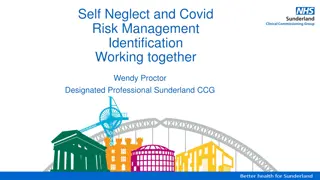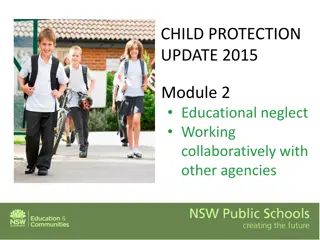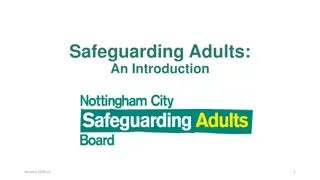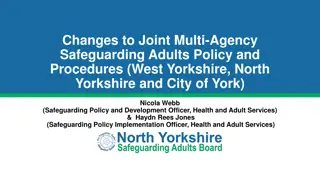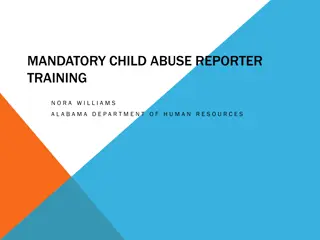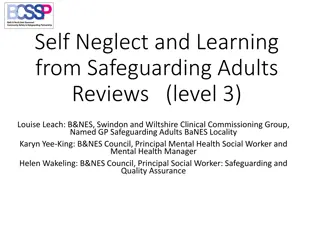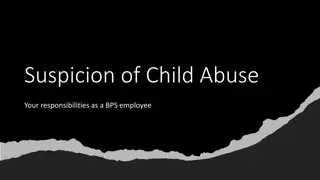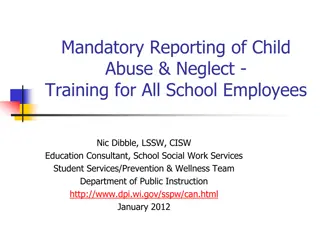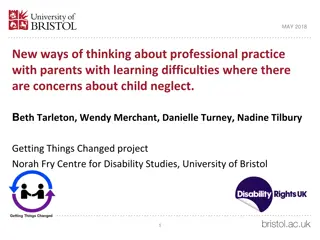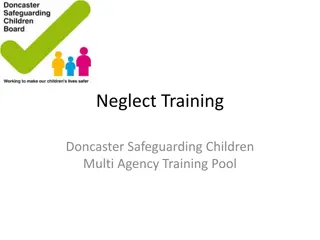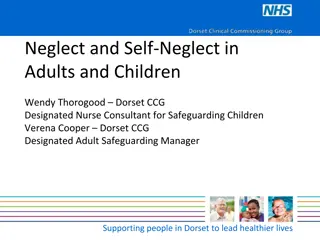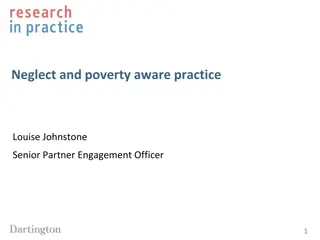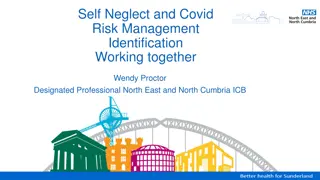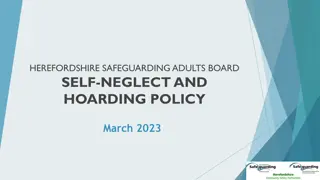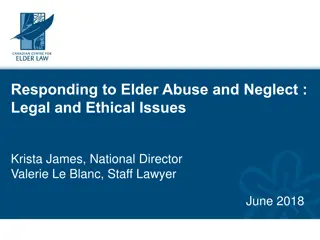Neglect
In this presentation, Dr. Shannon Wagner Simmons discusses the basic concepts, epidemiology, and psychiatric diagnostic issues related to child maltreatment. A clinical example of a teenage girl with a history of anxiety and trauma is presented, highlighting the importance of recognizing and addressing abuse and neglect in children. The prevalence and types of child maltreatment are outlined, emphasizing the significant impact on mental health. Definitions of physical abuse and neglect are provided, along with statistics and treatment approaches for children affected by trauma.
Download Presentation

Please find below an Image/Link to download the presentation.
The content on the website is provided AS IS for your information and personal use only. It may not be sold, licensed, or shared on other websites without obtaining consent from the author.If you encounter any issues during the download, it is possible that the publisher has removed the file from their server.
You are allowed to download the files provided on this website for personal or commercial use, subject to the condition that they are used lawfully. All files are the property of their respective owners.
The content on the website is provided AS IS for your information and personal use only. It may not be sold, licensed, or shared on other websites without obtaining consent from the author.
E N D
Presentation Transcript
Child Abuse and Neglect Shannon Wagner Simmons, MD, MPH Child and Adolescent Psychiatry Fellow Institute for Juvenile Research University of Illinois at Chicago
Objectives Review basic concepts and epidemiology of child maltreatment Discuss psychiatric diagnostic issues in abused or neglected children Provide an overview of the treatment of PTSD in children and adolescents, including a brief review of the psychopharmacology literature Discuss a clinical example
Jane Jane is a 15 year old girl with a history of a learning disorder who presents to an outpatient intake clinic with a two-month history of generalized anxiety and panic attacks. She had no prior psychiatric history. Medical history includes only mild asthma. Birth, developmental, and family histories are noncontributory. She has a younger sister who lives at home; parents are divorced.
Jane, continued She began weekly CBT with a psychology intern. In the fourth session, she disclosed to her therapist that she had been repeatedly raped by a family friend in her home over the summer. This family friend still visits the home often. I m not ready to tell my mom. Jane admits that she has been smoking marijuana several times weekly to manage her anxiety symptoms. She also endorses nightmares, flashbacks, and hypervigilance.
Jane A Few Questions If you were the therapist, what would you do next? What are you worried about? Why did she disclose this now? How would this information change your treatment approach?
Some Numbers 3 million suspected cases reported annually 1 million of these are substantiated 60% neglect, 20% physical abuse, 10% sexual abuse, 10% miscellaneous Lifetime incidence of maltreatment: 30% in child psychiatry outpatient populations 55% in child psychiatry inpatient populations
Some Definitions Physical Abuse: Intentional injury of a child by a caretaker that lead[s] to injury, and frequently occurs in the context of discipline. Neglect: Caretakers fail to appropriately provide for and protect children failing to meet the child s nutritional, supervision, or medical needs. From Lewis s Child and Adolescent Psychiatry: A Comprehensive Textbook
Some Definitions Sexual Abuse: Sexual behavior between a child and an adult or two children when one of them is significantly older or uses coercion may include exhibitionism Psychological Abuse: When an adult repeatedly conveys to a child that he is worthless, defective, unloved, or unwanted it may involve threatened or actual abandonment. From Lewis s Child and Adolescent Psychiatry: A Comprehensive Textbook
Child Risk Factors for Abuse Prematurity Age under 4 years Special Needs Disruptive behavior
Caregiver/Family Risk Factors for Abuse Poverty Substance Abuse Domestic Violence Caregiver history of being abused Transient nonrelated caregivers Social stressors
Psychiatric Sequelae Maltreated children are at risk for: o Attachment disorders o Social/peer relationship problems o Language delays o Below-average standardized test scores o Intimate Partner Violence o Teen parenthood o Perpetrating abuse o Age-inappropriate sexual behavior o Mood disorders o Anxiety disorders o Psychosis o Alcohol and drug abuse o Eating disorders o Disruptive behavior o Borderline personality disorder o Dissociative disorders
Predictors of More Favorable Long-Term Outcomes Consistent support system after the trauma Limited relationship with perpetrator Some genetic polymorphisms: 5HTTLPR (Serotonin Transporter Gene) and depression CRHR1 (Corticotropin-releasing hormone receptor) MAO-A (monoamine oxidase-A) and aggression Catechol-O-methyltransferase (COMT)
Diagnostic Issues Single-blow vs. chronic trauma Neglect vs. physical abuse Internalizing vs. externalizing Complex Trauma
Diagnostic Evaluation Maltreated children are at risk for a wide range of psychopathology. Developmental state at the time of trauma and at presentation is key. A thorough diagnostic assessment is indicated. We must ask the questions, sometimes several times. Mandated reporting issues
PTSD Three symptom clusters: re-experiencing, avoidant, and hyperarousal Some DSM criteria allow for developmental differences, but others do not. There is some controversy about how accurately these criteria capture the disorder in children, especially young children
PTSD Screening Tools UCLA PTSD index Trauma Symptom Checklist Anxiety Disorder Interview Schedule (ADIS) PTSD section Others Sometimes children report things on rating scales that they do not report verbally.
Treatment Planning The treatment should be tailored to the symptoms/disorder. Safety First: Be vigilant for ongoing maltreatment or re-traumatization Treatment often requires working with a larger multidisciplinary team and focusing on family and environmental factors
Trauma Focused CBT Considered best practice for children or teens who have experienced trauma Intervenes with both the child and caregivers Psychoeducation, relaxation skills, affective modulation, cognitive coping related to the trauma Creation of a trauma narrative Free web training: http://tfcbt.musc.edu/
Pharmacotherapy of PTSD Indications: Severe symptoms Suboptimal response to psychotherapy Comorbidity with a disorder amenable to pharmacotherapy (e.g. MDD) Combined approach (therapy + meds) is ideal
SSRIs in Pediatric PTSD Double-blind, placebo-controlled RCT: sertraline was comparable to placebo (Robb et al, 2010) Addition of placebo or citalopram to TF-CBT: no additional benefit in treatment group (Cohen et al, 2007) Open trial of citalopram in 8 patients: improvements seen (Seedat et al, 1999). That s all!
SSRIs: Things to Consider Black-box warning regarding suicidal ideation Children, especially those with severe mood dysregulation, may find SSRIs too activating The other usual side effects Start low, go slow
Other Agents in PTSD: Adrenergic Agents Clonidine reduced some PTSD symptoms in a small open trial of preschoolers (Harmon and Riggs, 1996). Guanfacine reduced nightmares in a case report involving a 7 year old (Horrigan, 1996). Prazosin reduced nightmares and hyperarousal in two adolescent case reports (Strawn et al, 2009; Fraleigh et al, 2009) Propranolol reduced PTSD symptoms in 11 school- aged children (Famularo et al, 1988)
Other Agents in PTSD: Atypical Antipsychotics Risperidone reduced hypervigilance and aggression in a teen (Keeshin and Strawn, 2009). When added to escitalopram, aripiprazole decreased nightmares in a teen (Yeh et al, 2010). Quetiapine decreased dissociation, anxiety, and depression in a series of 6 teens with PTSD (Stathis et al, 2005). Clozapine reduced aggression and improved sleep in a case series of six treatment-resistant teens
Other agents in PTSD: Mood Stabilizers Divalproex sodium caused a greater reduction of PTSD symptoms when given in high vs. low doses in 12 juvenile-detention teens (Steiner et al, 2007). In a case series of 28 children and teens with severe abuse history, most responded very well to carbamazepine (Looff et al, 1995).
Jane Revisited A Few Questions If you were the therapist, what would you do next? What are you worried about? Why did she disclose this now? How would this information change your treatment approach?
Useful Websites www.nctsn.org (National Child Traumatic Stress Network) www.aacap.org (American Academy of Child and Adolescent Psychiatry) Facts for Families Practice Parameters http://tfcbt.musc.edu/ (Trauma-Focused CBT)


